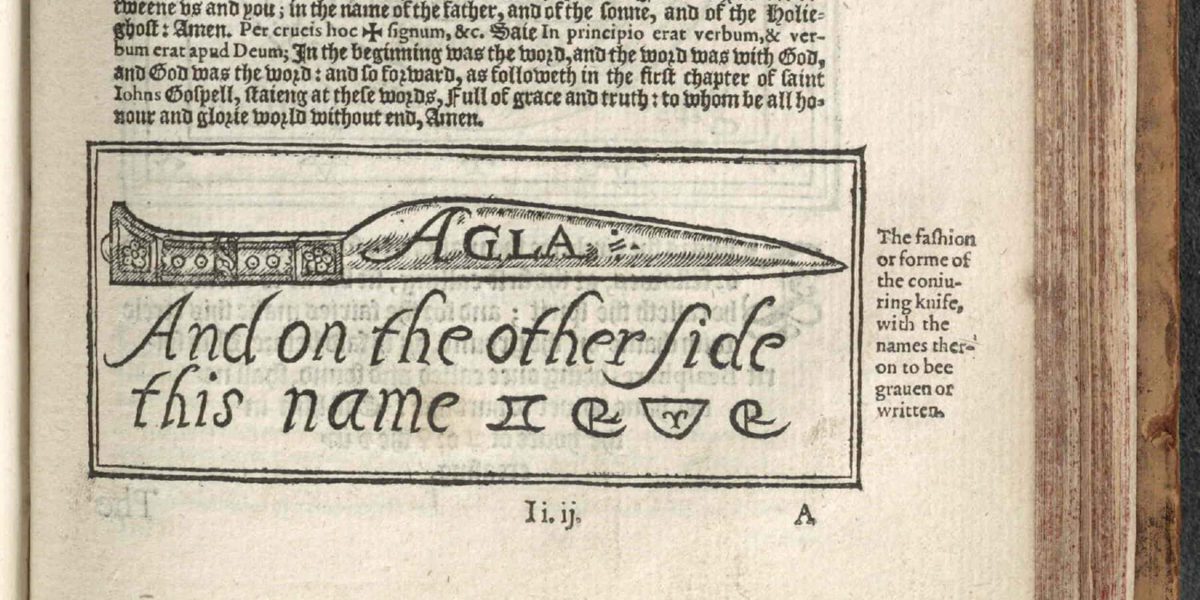wherein the lewde dealing of witches and witchmongers is notablie detected, the knauerie of coniurors, the impietie of inchantors, the follie of soothsaiers, the impudent falshood of cousenors, the infidelitie of atheists, the pestilent practises of Pythonists, the curiositie of figure casters, the vanitie of dreamers, the beggerlie art of Alcumystrie, the abhomination of idolatrie, the horrible art of poisoning, the vertue and power of naturall magike, and all the conueiances of Legierdemaine and iuggling are deciphered and many other things opened which have long lien hidden, howbeit verie necessarie to be knowne. Heerevnto is added a treatise vpon the nature and substance of spirits and diuels &c. all latelie written.
by Reginald Scot
The Discoverie of Witchcraft is a partially sceptical book published by the English gentleman, Reginald Scot in 1584, intended as an exposé of early Modern witchcraft.
Scot believed that the prosecution of those accused of witchcraft was irrational and un-Christian, and he held the Roman Church responsible. Popular belief held that all obtainable copies were burned on the accession of James I in 1603.
The maintenance of the superstition he blamed largely on the Roman Catholic Church, and he attacked writers including Jean Bodin (1530–1596), author of Démonomanie des Sorciers (Paris, 1580), and Jacobus Sprenger, supposed joint author of Malleus Maleficarum (Nuremberg, 1494).
Of Henri Cornelius Agrippa and Johann Weyer, author of De Præstigiis Demonum (Basle, 1566), whose views he adopted, he spoke with respect. Scot did adopt contemporary superstition in his references to medicine and astrology. He believed in the medicinal value of the unicorn’s horn, and thought that precious stones owed their origin to the influence of the heavenly bodies. The book also narrates stories of strange phenomena in the context of religious convictions. The devil is related with such stories and his ability to absorb people’s souls. The book also gives stories of magicians with supernatural powers performing in front of courts of kings.
In his lists of magical texts (chap. 31 and chap. 42) he mentions Ars Paulina, Ars Almadel, Ars Notoria, Honorius, Sepher Raziel, and others. Scot also reprints J. Wier’s (aka Wierus) Pseudomonarchia daemonum (1563), which corresponds closely to Lemegeton Book 1 (Goetia).
Scot’s text was expanded in 1665 by an anonymous author, who based on the text, was not akin to Scot’s when it came to his belief in magick.
Index to Grimoire section (A Collection of Magical texts)
| Booke IV. |
|---|
| Certeine popish and magicall cures, for them that are bewitched in their privitie |
| A strange cure done to one that was molested with Incubus. |
| Booke X. |
|---|
| How men have beene bewitched, cousened or abused by dreames to dig and search for monie [money]. |
| The art and order to be used in digging for monie, revealed by dreames, how to procure pleasant dreames, of morning and midnight dreames. |
| Sundrie receipts and ointments, made and used for the transportation of witches, and other miraculous effects: an instance therof reported and credited by some that are learned. |
| Booke XI. |
|---|
| The superstition of the heathen about the element of fier, and how it grew in such reverence among them, of their corruptions, and that they had some inkling of the godlie fathers dooings in that behalfe. |
| Of the Romane sacrifices: of the estimation they had of augurie, of the lawe of the twelve tables. |
| Colleges of augurors, their office, their number, the signification of augurie, that the practisers of that art were couseners, their profession, their places of exercise, their apparrell, their superstition. |
| The times and seasons to exercise augurie, the maner and arder thereof, of the ceremonies thereunto belonging. |
| Booke XII. |
|---|
| Popish periapts, amulets and charmes, agnus Dei, a wastcote of proofe, a charme for the falling evill, a writing brought to S. Leo from heaven by an angell, the vertues of S. Saviors epistle, a charme against theeves, a writing found in Christs wounds, of the crosse, &c. |
How to make holie water, and the vertues therof. S. Rufins charme, of the wearing and bearing of the name of Jesus, that the sacrament of confession and the eucharist is of as much efficacie as other charmes, & magnified by L. Vairus. |
| Choice of Charmes against the falling evill, the biting of a mad dog, the stinging of a scorpion, the toothach, for a woman in travell, for the Kings evill, to get a thorne out of any member, or a bone out of ones throte, charmes to be said fasting, or at the gathering of hearbs, for sore eies, to open locks, against spirits, for the bots in a horsse, and speciallie for the Duke of Albas horsse, for sowre wines, &c. |
| Booke XV. |
|---|
| Exposition of the word Iidoni. |
| Johann Wier: Pseudomonarchia daemonum. |
| The hours to bind demons. |
| The conjuration. |
| A confutation of the above. |
| Symbols of the planets, etc. |
| Symbols of the angels and magical seals. |
| An experiment of the dead [to invoke the virgin fairy Sibylia. |
| A licence for Sibylia to go and come. |
| To discover hidden treasure; to go invisible. |
| An experiment of Citrael. |
| How to enclose a spirit in a christall stone. |
| An experiment of Bealphares. |
| To bind the spirit Bealphares, and to lose him again. |
| Consecrating the holy water. |
| To make a spirit appear in a crystal. |
| An experiment of the dead. |
| A bond to bind him to thee. |
| To call him into your crystal stone. |
| When to talk with spirits, to find out theft. |
| A confutation. |
| A comparison with popish exorcism. |
A recent example of cousening by Franciscan friers. |
| Who may be conjurors in the Romish church. |
7 reasons that exorcisms fail. |
| Other gross absurdities of witchmongers. |
| Conjurations from the pontifical and missal. |
| That popish priests leave nothing unconjured; incense. |
| Rules of popish exorcists and others all one. St. Martin. |
| That it is a shame for papists to believe other conjurors… |
| The books of conjurors. |
| Magical arts confuted — Nero, Agrippa, Gallus. |
| Of Solomon’s conjurations. |
| Lessons read in all churches on St. Margaret’s day. |
| A delicate story of a Lombard; St. Vincent. |
| The story of St. Margaret demonstrated to be ridiculous. |
| A pleasant miracle wrought by a popish priest. |
| The former miracle confuted; story of St. Lucy. |
| Of visions, noises, apparitions — with a confutation. |
| Cardanus’ opinion of strange noises; St. Boniface. |
| Of a noise, and one that narrowly escaped drowning. |
| Of theurgy, with a confutation. |
| Supplementary material from 1665 edition. |
|---|
Of Magical Circles, and the reason of their Institution. |
| How to raise up the Ghost of one that hath hanged himself. |
| How to raise up the Spirits, Paymon, Bathin, and Barma: And what wonderful things may be effected through their assistance. |
| How to Consecrate all manner of Circles, fumigations, Fire, Magical Garments, and Utensills. |
| Treating more practically of the Consecration of Circles, Fires, Garments, and Fumigations. |
How to raise and exorcize all sorts of Spirits belonging to the Airy Region. |
| How to obtain the familiarity of the Genius or Good Angel, and cause him to appear. |
| A form of Conjuring Luridan the Familiar, otherwise called Belelah. |
| How to Conjure the Spirit Balkin the Master of Luridan. |




